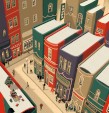Children’s author and illustrator, dancer, actor and multi-talented artist Remy Charlip died on August 14. He was 83.
Charlip was born on January 10, 1929 and grew up in Brooklyn. He showed a passion and talent for art from an early age and studied at Cooper Union School of Fine Arts in New York. But Charlip discovered, as he told one biographer, “being a painter seemed hopeless to me,” and he turned to other art forms including dance and acting. While studying at Black Mountain College in North Carolina, Charlip became a founding dancer at the Merce Cunningham Dance Theatre and remained with the company for 11 years as a principal dancer and company costume designer. In 1958 he co-founded the Paper Bag Players in New York, the longest-running children’s theater in the country.
Though he flourished in other art forms, Charlip never lost sight of writing and illustrating for children, and eventually published more than 38 books, which he often claimed helped support his other pursuits. His first published title was David’s Little Indian by Margaret Wise Brown (Young Scott Books, 1956) for which he provided the illustrations. The first book he both wrote and illustrated, Dress Up and Let’s Have a Party, appeared in 1956 from the same publisher. Critics have lauded Charlip’s work for its creative wordplay, humor and, in the case of 1975’s Thirteen, “absolute visual magic,” according to Milton Glaser in the New York Times Book Review.
Charlip worked with the National Theater for the Deaf as a director, which inspired two picture books on sign language, Handtalk: An ABC of Finger Spelling and Sign Language (Parents’ Magazine Press, 1974) and Handtalk Birthday: A Number and Story Book in Sign Language (Four Winds Press, 1987). His works have garnered three New York Times Best Illustrated Books awards and a first prize for illustration at the Bologna Book Fair, among other citations.
More recently, children’s book fans may also know that Charlip was the model for Brian Selznick’s drawings of filmmaker Georges Méliès in Selznick’s Caldecott Medal-winning book The Invention of Hugo Cabret. The two artists had been longtime friends and Selznick dedicated Hugo Cabret to Charlip.








